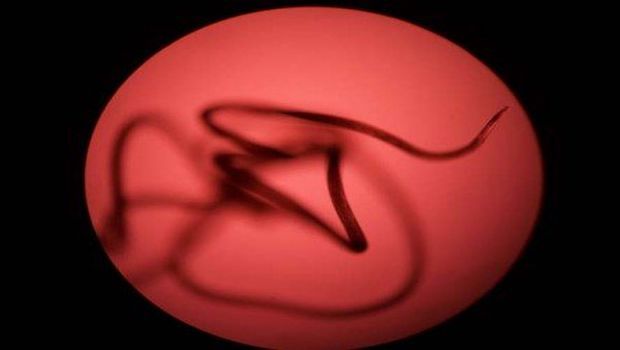Research Will Help to Refine Treatments for Global Parasitic Disease
Recently published research from Iowa State University biomedical scientists details new methods for studying a parasitic nematode that sickens millions worldwide, a development that could lead to improved therapies.


Burgia malayi, the parasitic nematode shown here, infects around 2 million people in tropical regions of Africa, South America and Asia. ISU biomedical scientists have made advances in understanding the parasite’s functional genomics. Courtesy of Richard Martin
Recently published research from Iowa State University biomedical scientists details new methods for studying a parasitic nematode that sickens millions worldwide, a development that could lead to improved therapies.
Richard Martin, a distinguished professor of biomedical sciences, has developed a means of determining the function of individual genes in Burgia malayi, a parasitic nematode that threatens populations in tropical regions of Africa, South America and Asia. The advancement will allow researchers to evaluate treatments that combat the disease caused by the parasites. The new method also may help scientists understand how the parasites develop resistance to medication, Martin said.
The nematodes, or microscopic roundworms, enter the body through the bite of insects. The nematodes settle in a host’s lymph nodes and cause severe swelling in the extremities, a condition known as elephantiasis. Martin said around 2 million people struggle with the disease worldwide, and no vaccine currently exists. That means treatment relies on anti-parasite drugs, but the nematodes have grown increasingly resistant to available medications in recent years, Martin said.
In an article published this week in the peer-reviewed academic journal Proceedings of the National Academy of Sciences, Martin and his team detail how to apply an established method known as RNAi, in which RNA molecules inhibit the expression of certain genes to the nematode that causes the disease. This opens up the possibility of exploring the parasite’s functional genomics, or the functions of specific genes, Martin said.
“We can sequence the genome of virtually anything. The question is, ‘What do these genes do?’ We call this functional genomics, and we’re able to apply this to this particular nematode for the first time,” Martin said.
The advancement will allow researchers to pinpoint the parts of the parasite’s genome that respond to drugs and study how the medications affect the organism.
“That’s valuable because we want to start thinking about using the medications in combination with one another to make them more effective,” Martin said.
Studying the functional genomics of the parasite also will help researchers see how the nematodes develop resistance to the drugs and potentially counter that resistance. Martin said scientists now will be able to monitor how some specimens recover from an initial treatment, an important step in making treatments more effective.
Source: Iowa State University
Robust infectious disease surveillance, including rapid subtyping of influenza A, is essential for early detection, containment, and public health reporting of novel viral threats.